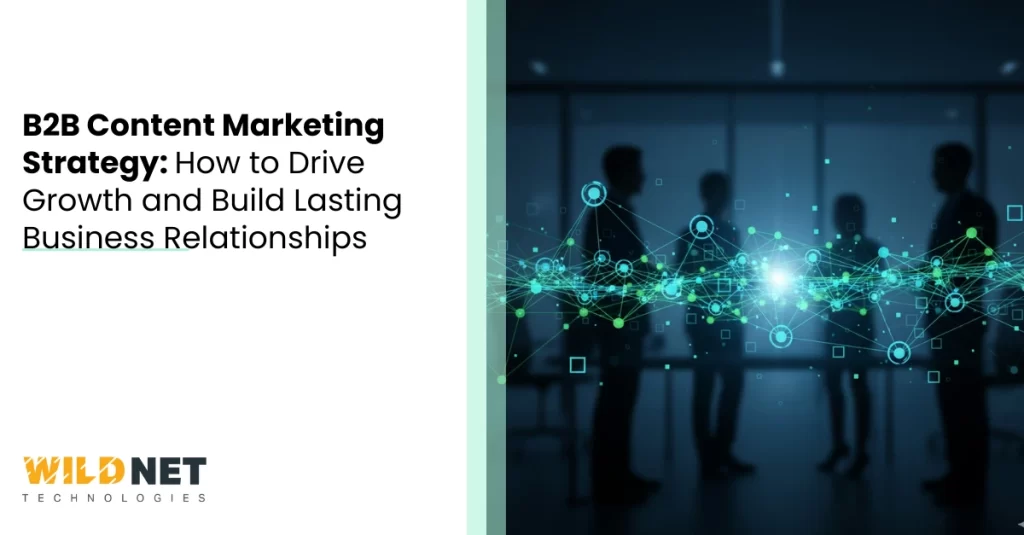In today’s competitive business environment, creating an effective B2B content marketing strategy isn’t just an option—it’s a necessity. With buyers becoming more informed and decision-making processes getting longer, businesses must build trust and deliver consistent value through content.
A solid strategy helps organizations reach the right audience, nurture leads, and position themselves as industry leaders. Whether you’re a startup entering the B2B space or an established brand looking to refine your marketing approach, understanding how to design and execute a high-performing content strategy can significantly elevate your results.
What Is a B2B Content Marketing Strategy?
A B2B content marketing strategy is a structured plan to create, distribute, and promote valuable content to attract and retain business clients. Unlike B2C marketing, which targets individual consumers, B2B content marketing is designed to reach decision-makers in organizations—CEOs, CMOs, managers, and procurement specialists—who make rational, data-driven purchasing decisions.
In essence, it’s about producing informative, insightful, and problem-solving content that speaks directly to other businesses’ pain points and goals. Instead of aggressively pushing sales, it focuses on building credibility, demonstrating expertise, and creating long-term relationships that eventually drive conversions.
Why B2B Content Marketing Matters More Than Ever
Modern buyers have changed. Research shows that 70% of B2B buyers consume multiple content before engaging with a sales representative. Content is the bridge that builds awareness, trust, and authority—long before a salesperson steps in.
Here’s why B2B content marketing is indispensable:
- Educates prospects before the sales pitch begins.
- Strengthens brand authority by positioning your company as an industry thought leader.
- Improves lead quality, as well-informed leads are more likely to convert.
- Boosts organic visibility through SEO-optimized, high-value content.
- Reduces sales cycles by pre-answering common objections through content.
With the right content marketing approach, B2B companies can smoothly transition prospects from awareness to decision-making without resorting to hard-sell tactics.
Key Pillars of an Effective B2B Content Marketing Strategy
Creating a winning B2B content marketing strategy involves more than just writing blog posts. It’s about aligning business goals with the correct type of content, channels, and audience insights. Let’s break down the essential components:
1. Define Clear Goals and Objectives
Every successful strategy starts with clarity. What do you want your content to achieve?
Some common objectives include:
- Generating qualified leads
- Increasing brand visibility
- Nurturing existing clients
- Driving traffic to product pages
- Supporting account-based marketing (ABM) efforts
Ensure your goals are SMART—Specific, Measurable, Achievable, Relevant, and Time-bound. This clarity helps you measure success accurately and adjust your strategy effectively.
2. Understand Your Audience and Buyer Personas
In B2B, understanding your audience is non-negotiable. You’re not selling to individuals but to organizations with multiple stakeholders. Each stakeholder has different pain points, responsibilities, and decision-making power.
Create buyer personas that represent your ideal customers. Include details such as:
- Job title and role in the organization
- Key challenges and goals
- Industry and company size
- Decision-making authority
- Preferred content formats
The more specific your personas, your content will be more personalized and impactful.
3. Map the Buyer’s Journey
The B2B buyer’s journey typically has three stages—Awareness, Consideration, and Decision. Your content should align with each of these stages:
- Awareness: Focus on educational content like blogs, infographics, and industry reports.
- Consideration: Create case studies, webinars, and whitepapers that show how your solutions solve specific problems.
- Decision: Offer product demos, testimonials, and ROI-focused materials to help finalize decisions.
By mapping content to each stage, you ensure a consistent flow of value that nurtures prospects toward conversion.
4. Choose the Right Content Types
A robust B2B strategy leverages diverse content formats to engage audiences across platforms. Some top-performing formats include:
- Blog posts and articles: Build SEO authority and thought leadership.
- Whitepapers and eBooks: Offer in-depth insights to capture leads.
- Case studies: Demonstrate tangible results and credibility.
- Videos and webinars: Simplify complex topics and humanize your brand.
- Podcasts: Build community and expand reach among professionals.
- Email newsletters: Maintain ongoing communication with leads and clients.
Experimenting with multiple formats ensures you reach decision-makers in the channels they prefer.
5. Develop a Strong Content Calendar
Consistency is key in content marketing. A content calendar helps you plan, organize, and execute your strategy efficiently. It should include:
- Publishing frequency
- Content themes
- Distribution channels
- Responsible teams or individuals
- Deadlines and review timelines
Regular publishing builds trust and familiarity, vital components of long-term B2B relationships.
6. Optimize for SEO and Discoverability
Even the most insightful content is useless if no one finds it. Optimize every content for search engines using the right keywords, headings, and metadata. Focus on:
- On-page SEO (titles, meta descriptions, internal linking)
- Targeting long-tail keywords relevant to your industry
- Structuring content for readability and engagement
- Adding backlinks from reputable industry sources
SEO ensures your brand consistently attracts organic traffic and stays visible in competitive B2B markets.
7. Distribute Content Across the Right Channels
Content distribution is as important as creation. Identify where your audience spends time and share your content strategically.
Top B2B distribution channels include:
- LinkedIn (the most powerful B2B networking platform)
- Email marketing
- Industry-specific forums and communities
- Guest posting on niche websites
- Paid content promotion
Remember: great content deserves excellent distribution. Without it, even your best material may go unnoticed.
8. Personalization and Account-Based Marketing (ABM)
B2B buyers expect customized experiences. Use personalization techniques to tailor your content to specific industries, companies, or job roles.
Account-Based Marketing (ABM) takes this to the next level by targeting high-value accounts with hyper-relevant content. When combined with content marketing, ABM helps businesses build deep, trust-based relationships that often result in larger deals.
9. Measure and Analyze Performance
To ensure your efforts deliver ROI, track key performance metrics such as:
- Website traffic and engagement rate
- Lead quality and conversion rate.
- Content downloads and shares
- Keyword rankings
- Customer acquisition cost (CAC)
Analytics tools like Google Analytics, HubSpot, and SEMrush can provide data-driven insights into what’s working and needs refinement.
10. Repurpose and Refresh Existing Content
Not every piece of content needs to be brand new. Repurposing saves time while extending the lifespan of your best-performing assets. For instance:
- Turn a blog post into an infographic or video.
- Convert webinar transcripts into a downloadable guide.
- Update old blogs with fresh statistics and insights.
This approach helps maintain content consistency and maximize ROI without constant reinvention.
Integrating Storytelling into B2B Content
While B2B audiences are logical decision-makers, they’re still human. Storytelling helps humanize your brand, making your message memorable and persuasive.
Use real-life success stories, customer journeys, or challenges faced during product development. This narrative-driven approach turns dry data into emotionally resonant content, helping your brand stand out in a saturated market.
Common Mistakes to Avoid in B2B Content Marketing
Many B2B companies fail to achieve desired results because they overlook certain critical factors. Avoid these pitfalls:
- Overly promotional content that lacks educational value.
- Ignoring data and analytics while planning a strategy.
- Neglecting content distribution.
- Inconsistent publishing schedules.
- Not aligning marketing and sales teams.
A successful B2B content marketing strategy requires coordination, patience, and long-term vision—not just sporadic content efforts.
The Future of B2B Content Marketing
The B2B content landscape is rapidly evolving. Emerging technologies like AI, automation, and predictive analytics transform how businesses create and deliver content.
We’ll see more interactive content, video-based learning, and personalized experiences powered by data intelligence. Brands that stay agile, invest in quality content, and focus on customer-centric storytelling will dominate the next era of B2B marketing.
Partnering with experienced professionals who offer digital marketing services can help streamline this transformation by bringing advanced tools, analytics, and strategy expertise under one roof.
Conclusion
A well-structured B2B content marketing strategy is the backbone of sustainable business growth. It empowers companies to connect meaningfully with decision-makers, demonstrate expertise, and build credibility that translates into long-term success.
From defining clear goals to optimizing for SEO, every element is crucial in converting content into measurable business outcomes. With consistency, data-driven insights, and creativity, your brand can turn every piece of content into a growth engine that drives awareness, trust, and sales.
For expert guidance and tailored execution of your B2B content marketing strategy, consider collaborating with Wildnet Technologies — their team is equipped to help you build impactful content, reach key decision-makers, and drive measurable business growth.
Frequently Asked Questions (FAQs)
1. What makes B2B content marketing different from B2C?
B2B content marketing targets business decision-makers with logical, data-driven messaging, while B2C focuses on emotional appeal for individual consumers.
2. How often should a B2B company publish content?
Consistency matters more than frequency. Publishing high-quality content weekly or biweekly can yield better engagement than frequent, low-value posts.
3. What are the best content formats for B2B marketing?
Blogs, whitepapers, case studies, webinars, and videos are the most effective formats for educating and engaging B2B audiences.
4. How do I measure the success of my B2B content strategy?
Track KPIs such as organic traffic, lead generation, conversion rates, and engagement metrics to assess your content’s effectiveness.
5. Is social media important for B2B content marketing?
Yes, platforms like LinkedIn and X (formerly Twitter) are powerful for sharing content, building authority, and connecting with industry professionals.
Read More







